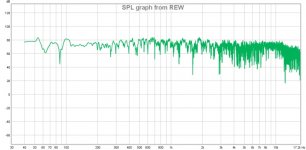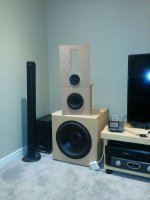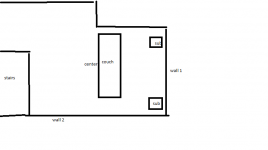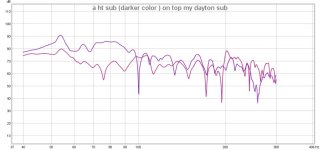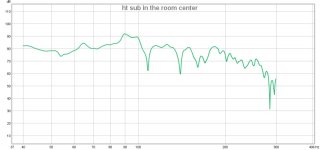Hello , I trying to equalize my setup , I have a 3 way with a active crossover .
So my speakers are in the basement so concrete wall behind it and on the right side on the left side it has a wood/drywall wall.
After some measurements with REW , I found out there are some big dips one on ~60hz and another ~90hz . the subwoofer dedicated to 37 to 300hz is a dayton RSS390HF so a very capable sub on a 3 cu ft sealed cabinet.
Anyone could give tips how to fix those dips.. I know I can't equalize it out of them.
Thanks.
ps. I did attached two pics one this the REW spl graph and another a pic of the speaker. and part of the room
So my speakers are in the basement so concrete wall behind it and on the right side on the left side it has a wood/drywall wall.
After some measurements with REW , I found out there are some big dips one on ~60hz and another ~90hz . the subwoofer dedicated to 37 to 300hz is a dayton RSS390HF so a very capable sub on a 3 cu ft sealed cabinet.
Anyone could give tips how to fix those dips.. I know I can't equalize it out of them.
Thanks.
ps. I did attached two pics one this the REW spl graph and another a pic of the speaker. and part of the room
Attachments
Last edited:
You'll probably need to move the speakers, get them as far from the side walls and back wall as possible.
Mike
Mike
What place of the room did you measure fr response in?
Hello , I got the measurement from the center of the couch ( ~ 10 FT from the speakers ).
The fact of having the sub too close to the floor ( that is a carpet over concrete ) has any impact on this problem?
um, for once your bass is the least of your issues. you need some serious room treatment first. that hf response is terrible. call gik acoustics for advice.
erik
erik
um, for once your bass is the least of your issues. you need some serious room treatment first. that hf response is terrible. call gik acoustics for advice.
erik
Thanks , to get a better response over 10khz I move the mid and the tweeter on my direction , by the way my tweeter isn't in a proper cabinet yet.
and it is a satori TW29R .
Your resolution is too poor, you cannot see much of any details. So, adjust the Y-axis (dB) to max 90 and minimum +40 and measure only 1 speaker at a time. Start with your results below 250-350 Hz and forget midrange and treble until later. Room dependent midrange and treble problems are easily fixed compared to bass problems which "never" are. 1 st step to fix bass problems is to find best placement of speakers and listening position. 2nd step would be bass traps if the room volume / spouse allow them (they take up alot of space). 3rd would be EQ for peaks, dips cannot be easiliy fixed if they are due to SBIR.
You will probably find 3 or 4 rather deep dips from each speaker dur to SBIR. Then make a measurement with both speakers. Combined speakers may improve or worsen dips and peaks. Results? Problem areas for each speaker and combined speakers?
Turn on the RTA in REW and play pink noise through 1 speaker. Slowly walk backwards/ forwards and sideways with microphone at ear height while you check your screen and the response in the problem areas. What you are doing now is mapping your room, to get a feel for good and bad placements of speakers and listening positions. Take notice of how little/much you have to move the microphone to get "substantial" dB-changes for different frequencies and also which movement direction giving that change, forward, sideways, up/down. Change the speaker position and do it again and again and again.
The RTA only show a 1/3 octave resolution (if I remember correctly, it's a long time since I used RW last time) but you can fairly quickly narrow down good and bad spots and placements. Then it is time to measure more carefully with better 1/12 or 1/24 octave. Note though, it is with REW's ETC measurements and the waterfall diagrams you sort out the room problems speaker and LP placements as well as possible absorbers and diffusers, not by looking at the frequency response curve.
You will probably find 3 or 4 rather deep dips from each speaker dur to SBIR. Then make a measurement with both speakers. Combined speakers may improve or worsen dips and peaks. Results? Problem areas for each speaker and combined speakers?
Turn on the RTA in REW and play pink noise through 1 speaker. Slowly walk backwards/ forwards and sideways with microphone at ear height while you check your screen and the response in the problem areas. What you are doing now is mapping your room, to get a feel for good and bad placements of speakers and listening positions. Take notice of how little/much you have to move the microphone to get "substantial" dB-changes for different frequencies and also which movement direction giving that change, forward, sideways, up/down. Change the speaker position and do it again and again and again.
The RTA only show a 1/3 octave resolution (if I remember correctly, it's a long time since I used RW last time) but you can fairly quickly narrow down good and bad spots and placements. Then it is time to measure more carefully with better 1/12 or 1/24 octave. Note though, it is with REW's ETC measurements and the waterfall diagrams you sort out the room problems speaker and LP placements as well as possible absorbers and diffusers, not by looking at the frequency response curve.
You should perhaps also try to measure your room at different places to see how much it affects the FR.
It should help to characterize your room and identify a good unexpected listening zone ?
It should help to characterize your room and identify a good unexpected listening zone ?
Your resolution is too poor, you cannot see much of any details. So, adjust the Y-axis (dB) to max 90 and minimum +40 and measure only 1 speaker at a time. Start with your results below 250-350 Hz and forget midrange and treble until later. Room dependent midrange and treble problems are easily fixed compared to bass problems which "never" are. 1 st step to fix bass problems is to find best placement of speakers and listening position. 2nd step would be bass traps if the room volume / spouse allow them (they take up alot of space). 3rd would be EQ for peaks, dips cannot be easiliy fixed if they are due to SBIR.
You will probably find 3 or 4 rather deep dips from each speaker dur to SBIR. Then make a measurement with both speakers. Combined speakers may improve or worsen dips and peaks. Results? Problem areas for each speaker and combined speakers?
Turn on the RTA in REW and play pink noise through 1 speaker. Slowly walk backwards/ forwards and sideways with microphone at ear height while you check your screen and the response in the problem areas. What you are doing now is mapping your room, to get a feel for good and bad placements of speakers and listening positions. Take notice of how little/much you have to move the microphone to get "substantial" dB-changes for different frequencies and also which movement direction giving that change, forward, sideways, up/down. Change the speaker position and do it again and again and again.
The RTA only show a 1/3 octave resolution (if I remember correctly, it's a long time since I used RW last time) but you can fairly quickly narrow down good and bad spots and placements. Then it is time to measure more carefully with better 1/12 or 1/24 octave. Note though, it is with REW's ETC measurements and the waterfall diagrams you sort out the room problems speaker and LP placements as well as possible absorbers and diffusers, not by looking at the frequency response curve.
Thanks for the step by step troubleshooting. these subs weight 82 pounds ( not ease to move 🙂 ).
I will try tomorrow and I will post here any finding.
You should perhaps also try to measure your room at different places to see how much it affects the FR.
It should help to characterize your room and identify a good unexpected listening zone ?
thanks
How can you tell? It's a 200 dB scale and un-smoothed. 😱 It doesn't look great, but it's hard to judge. I don't go over about a 70dB scale and use 1/3 and 1/6 octave smoothing.you need some serious room treatment first. that hf response is terrible.
Thanks for the step by step troubleshooting. these subs weight 82 pounds ( not ease to move 🙂 ).
I will try tomorrow and I will post here any finding.
With 2 subs, a common placement would be right up against your front wall and 1/4 distance in from the side wall for each sub (comparedto room width). That way you create an endless mirror image source of subs and you will receive an even bass response for all people sitting beside each other in the sofa. (Bass modes from length and height still remain.) Now, as you have "flimsy" wood panel and drywall side walls, that theoretical 1/4 distance will not be totally correct and probably has to be adjusted somewhat. Measurements will tell. To find the acoustical center of the room versus width, place 1 sub in the corner play that RTA and move the mic sideways. At the center you will have a deep null for 1 st and 3 rd width mode and a peak for the 2nd. That acoustical center versus width probably deviates from the "physical" center between side walls. It can be a little, it can be substantial, depends on how flimsy the side walls are and how far away you have a more heavy wall.
For the positioning of your LP versus length (and width), you can follow the steps here: https://www.gearslutz.com/board/9027803-post14.html
RTA measurements are only to give you a rough and quick picture how of the room influences speakers and placements, so switch over to real measurements with sweeps and higher resolution in the diagrams, just as Brandt writes.
These measurements take time, let them take time and take careful notes on the whereabouts of each measurement. If you don't, you will soon have no idea what was crucial to reach that really good result.
Edit: That starting position in the link, 38% or 3/8 of room length, can be from the front wall or the wall behind you, -your chooice. In control rooms one usually go for the front wall / speaker wall and sit close to the speakers.
Last edited:
With 2 subs, a common placement would be right up against your front wall and 1/4 distance in from the side wall for each sub (comparedto room width). That way you create an endless mirror image source of subs and you will receive an even bass response for all people sitting beside each other in the sofa. (Bass modes from length and height still remain.) Now, as you have "flimsy" wood panel and drywall side walls, that theoretical 1/4 distance will not be totally correct and probably has to be adjusted somewhat. Measurements will tell. To find the acoustical center of the room versus width, place 1 sub in the corner play that RTA and move the mic sideways. At the center you will have a deep null for 1 st and 3 rd width mode and a peak for the 2nd. That acoustical center versus width probably deviates from the "physical" center between side walls. It can be a little, it can be substantial, depends on how flimsy the side walls are and how far away you have a more heavy wall.
For the positioning of your LP versus length (and width), you can follow the steps here: https://www.gearslutz.com/board/9027803-post14.html
RTA measurements are only to give you a rough and quick picture how of the room influences speakers and placements, so switch over to real measurements with sweeps and higher resolution in the diagrams, just as Brandt writes.
These measurements take time, let them take time and take careful notes on the whereabouts of each measurement. If you don't, you will soon have no idea what was crucial to reach that really good result.
Edit: That starting position in the link, 38% or 3/8 of room length, can be from the front wall or the wall behind you, -your chooice. In control rooms one usually go for the front wall / speaker wall and sit close to the speakers.
thanks again.
How can you tell? It's a 200 dB scale and un-smoothed. 😱 It doesn't look great, but it's hard to judge. I don't go over about a 70dB scale and use 1/3 and 1/6 octave smoothing.
So glad I'm not the only one thinking that 🙂.
Instead of the 1/3 and 1/6 smoothing I'd suggest looking at a frequency dependent window of 1/6 octave and a bit higher (1/12 oct) to learn what part is the room/speaker integration. You should see the main dips as they develop. REW has such a feature in the IR settings menu.
Don't boost the dips, try and move the subs, even if it's a heavy job 😀.
So glad I'm not the only one thinking that 🙂.
Instead of the 1/3 and 1/6 smoothing I'd suggest looking at a frequency dependent window of 1/6 octave and a bit higher (1/12 oct) to learn what part is the room/speaker integration. You should see the main dips as they develop. REW has such a feature in the IR settings menu.
Don't boost the dips, try and move the subs, even if it's a heavy job 😀.
Thanks
I've experimented a similar problem in a small room, the dip was around 70-90Hz and no bass under 50Hz.
70-90Hz solved by adding one 8in dipolar woofer on each channel with an active LR24 filtrer LP@75Hz and HP@100Hz.
50Hz solved by adding two 10in dipolar woofers at a strategic point of the room with an active LR24 filtrer LP@30Hz and HP@75Hz.
The response is flat... without acoustic treatements but i have nothing under 40Hz.
70-90Hz solved by adding one 8in dipolar woofer on each channel with an active LR24 filtrer LP@75Hz and HP@100Hz.
50Hz solved by adding two 10in dipolar woofers at a strategic point of the room with an active LR24 filtrer LP@30Hz and HP@75Hz.
The response is flat... without acoustic treatements but i have nothing under 40Hz.
ftom an fr perspective, you are correct. from a time domain, that hf which looks like the ends of a brush would imply to me there are too mamy reflections happening too soon. i would treat that first, before bothering to consider the eq.
ftom an fr perspective, you are correct. from a time domain, that hf which looks like the ends of a brush would imply to me there are too mamy reflections happening too soon. i would treat that first, before bothering to consider the eq.
You are right, it is important to have a global approach to ensure that there is no major ringings in the time domain.
I've find my solution by testing near every loudspeakers positions in the room and a lot of loudpeakers configurations.
It is not an equalization, all the loudspeakers are a the same SPL, they are just tailored for the room.
Last edited:
Measurements on different locations
Hello , I spent some time trying to check fr responses on different locations
Because my music subs are too heavy , I used my home theater sub in different locations . I also put a draw of my basement .
the only place that seams to have a better response and the place could be accept by my wife is behind the couch on the center of the room.
I also went to a company here in montreal specialized on acoustic treatment ,
they recommend some bass traps on the corners where I have my music subs now. and at least 400 bucks for the basic apparatus .
what you guys think about the measurements?
Thanks in advance.
Hello , I spent some time trying to check fr responses on different locations
Because my music subs are too heavy , I used my home theater sub in different locations . I also put a draw of my basement .
the only place that seams to have a better response and the place could be accept by my wife is behind the couch on the center of the room.
I also went to a company here in montreal specialized on acoustic treatment ,
they recommend some bass traps on the corners where I have my music subs now. and at least 400 bucks for the basic apparatus .
what you guys think about the measurements?
Thanks in advance.
Attachments
Last edited:
- Status
- Not open for further replies.
- Home
- General Interest
- Room Acoustics & Mods
- Looking for suggestions on room equalization
